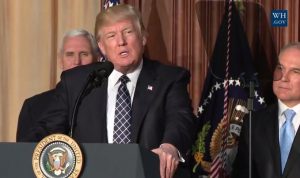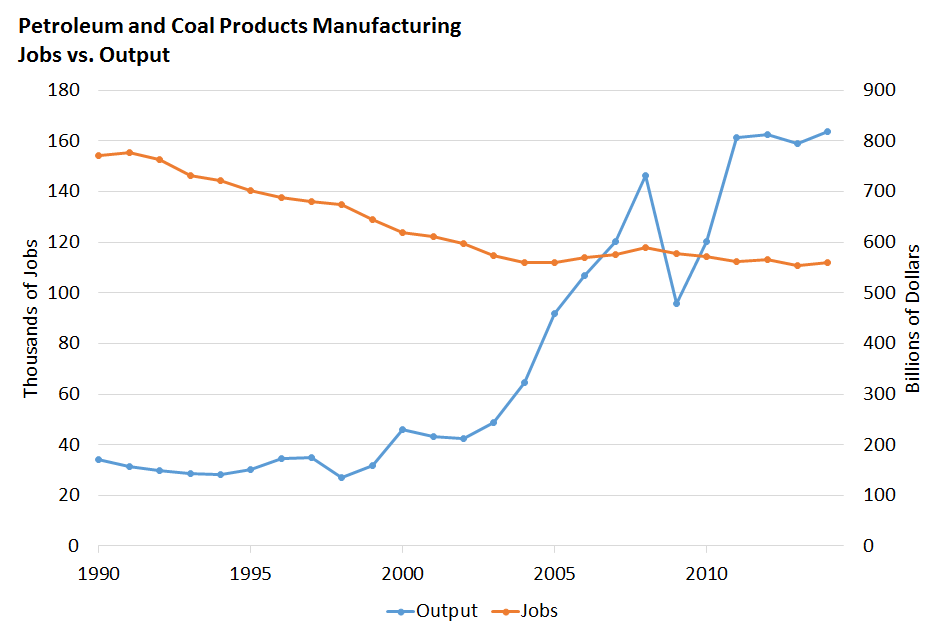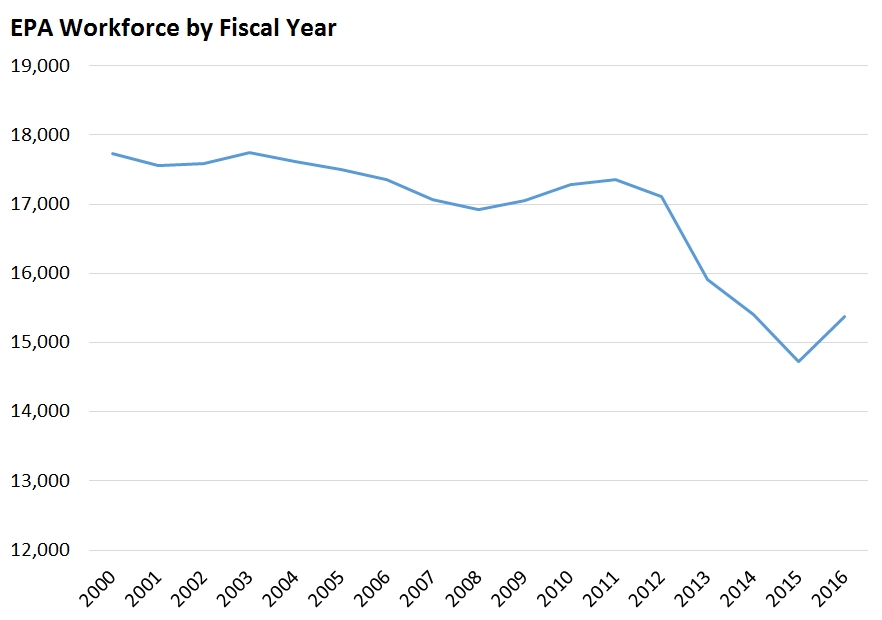
Repealing Environmental Rules Part of False Narrative of EPA’s “Job Killing” Regulations
Washington, D.C. – During the signing of an executive order today promising the roll back of federal climate and coal regulations, President Donald Trump repeated false claims about “job killing” EPA regulations and made dubious promises to bring back coal mining jobs.
“Today, my administration is putting an end to the war on coal…. We are going to cancel job-killing regulations,” Trump said at EPA headquarters, surrounded by coal miners and administration officials, during a signing ceremony for his “Energy Independence” executive order. The order calls for an end to the Obama Administration’s carbon dioxide regulations for coal-fired power plants (the “Clean Power Rule”) and moratorium on coal mining leases on federal land, among other rules.
Trump’s assertions about job losses have no basis in evidence. Data from U.S. Bureau of Labor Statistics shows that two tenths of one percent of mass layoffs (defined as layoffs of more than 50 people) are caused by government regulations of any kind, including environmental regulations.[i] Layoffs are caused far more often by corporate buyouts, technological advances, and lower overseas labor costs.
“The evidence shows that there is simply no truth to the idea that regulations kill jobs or stifle growth,” said Eric Schaeffer, Executive Director of the Environmental Integrity Project. “In fact, regulations provide huge economic benefits to our society, with minimal, though generally positive, effects on jobs and productivity. On the other hand, the absence of regulation can have severe economic consequences, with perhaps the most notable example being the 2008 financial collapse.”
Here are some fictions about EPA that Trump and his allies frequently repeat, followed by the facts.
FICTION #1: President Obama’s EPA bankrupted the coal industry.
FACT #1: Over the last decade, technological innovations in the drilling industry — hydraulic fracturing and horizontal drilling – produced such a glut of natural gas that gas became cheaper than coal as a fuel for coal-fired power plants, making coal no longer economically competitive. Wind, solar and other renewables also became much cheaper and competed more effectively with coal. Low prices for natural gas and other sources of energy bankrupted coal companies, not EPA.[ii]
FICTION #2: EPA regulations have been driving the oil and gas industry out of business. “Environmental regulations have been a large contributor to the energy problems we now face and have put an unnecessary drag on our overall economy,” Senator James Inhofe, Republican of Oklahoma, proclaims on his website.[iii]
FACT #2: Oil and gas production skyrocketed under Obama’s EPA. Fueled by advances in horizontal drilling and hydraulic fracturing (which Obama praised[iv]), natural gas production in the U.S. vaulted 34 percent from 2008 to 2015, rising from 20,158,602 million cubic feet in 2008 to 27,059,503 million cubic feet in 2015, according to the Energy Information Administration.[v] During this boom, America became No. 1 gas producer in the world — hardly evidence of an industry “killed” by EPA.[vi] Crude oil production in the U.S. nearly doubled between 2008 and 2015, from an average 5 million barrels per day to 9.42 million in 2015.
It is true that some oil and gas companies suffered layoffs in 2015 and 2016. But this was largely a self-inflicted wound caused by the excesses of the natural gas industry itself, which drilled so many wells and unleashed such a glut of gas and oil that prices plummeted, making drilling less profitable.[vii] In early 2017, oil prices and production are picking up again. But as the industry becomes more profitable, it is choosing not to hire more workers, instead increasingly relying on automation instead of human labor.[viii]
FICTION #3: The petroleum and coal industries are “job creators” that will hire more people if they are allowed to produce more fuel. President Donald Trump’s website proclaims: “The Trump Administration will embrace the shale oil and gas revolution to bring jobs and prosperity to millions of Americans.”[ix]
 FACT #3: Both the oil & gas and coal mining industries are increasingly mechanizing their operations to eliminate jobs, so they can increase profit for shareholders without hiring workers. According to the U.S. Bureau of Labor Statistics, the petroleum and coal products manufacturing industries cut their workforce by 27 percent between 1990 and 2015 while boosting their annual output more than four fold, from $171 billion to $818 billion. So expansion of the industry doesn’t necessarily mean an expansion of jobs.[x]
FACT #3: Both the oil & gas and coal mining industries are increasingly mechanizing their operations to eliminate jobs, so they can increase profit for shareholders without hiring workers. According to the U.S. Bureau of Labor Statistics, the petroleum and coal products manufacturing industries cut their workforce by 27 percent between 1990 and 2015 while boosting their annual output more than four fold, from $171 billion to $818 billion. So expansion of the industry doesn’t necessarily mean an expansion of jobs.[x]
FICTION #4: We don’t need a strong EPA, because the states can enforce environmental laws. U.S. Senator Dan Sullivan, a Republican from Alaska, said on February 16 during the senate confirmation debate on Scott Pruitt as EPA Administrator: “The states are the primary protectors and implementers of our environmental protections laws. That’s in the law – that’s in the federal law.”[xi]
FACT #4: Pollution flows across state lines, and the federal Clean Air Act clearly states that EPA has a leadership role in establishing standards that the states must follow. “Federal financial assistance and leadership is essential for the development of cooperative Federal, State, regional, and local programs to prevent and control air pollution,” the law states.[xii] The federal Clean Air Act also specifies that EPA is in charge of enforcing the law and making sure the states follow it: “Except as otherwise expressly provided in this Act, the Administrator of the Environmental Protection Agency shall administer this Act,” the law states.[xiii]
FICTION #5: EPA has been growing out of control. “Bureaucracy, by its nature, metastasizes, and the EPA has grown larger while its contribution to public health is getting smaller and smaller,” Republican former White House Council C. Boyden Gray, wrote in a Dec. 28, 2016, Op Ed in the Washington Examiner.[xiv]
 FACT #5: EPA shrank during the Obama Administration, falling to 15,376 employees in 2016 from 16,916 in 2008 to according to federal records.[xv] In fact, the agency was larger under Republican President George W. Bush, who employed 17,558 workers at EPA in 2001 and 17,072 in 2007.
FACT #5: EPA shrank during the Obama Administration, falling to 15,376 employees in 2016 from 16,916 in 2008 to according to federal records.[xv] In fact, the agency was larger under Republican President George W. Bush, who employed 17,558 workers at EPA in 2001 and 17,072 in 2007.
Meanwhile, EPA’s enforcement of environmental laws is preventing an increasing number of deaths and illnesses. The enforcement of one law alone – the 1990 amendments to the Federal Clean Air Act – prevented about 160,000 premature deaths from particulate (soot) pollution in 2010, along with 1.7 million asthma attacks prevented annually, 3.2 million lost school days, and 54,000 cases of bronchitis annually.[xvi] These numbers are expected to rise to 230,000 prevented deaths a year by 2020, along with 2.4 million asthma attacks, 5.4 million lost school days, and 75,000 cases of bronchitis.
For more information, read the Environmental Integrity Project’s report, “Don’t Believe the Job Killer Hype.”
The Environmental Integrity Project is a 15-year-old nonprofit, nonpartisan organization, based in Washington D.C., dedicated to enforcing environmental laws and holding polluters and governments accountable to protect public health.
Media contact: Tom Pelton, Environmental Integrity Project (202) 888-2703 or tpelton@environmentalintegrity.org
[i] U.S. Bureau of Labor Statistics, “Extended Mass Layoffs in 2012,” September 2013. Link: https://www.bls.gov/mls/mlsreport1043.pdf
[ii] Lauren Carroll, “Hillary Clinton says market forces made coal companies go bankrupt,” Politifact, May 10th, 2016. Link: http://www.politifact.com/truth-o-meter/statements/2016/may/10/hillary-clinton/hillary-clinton-says-market-forces-made-coal-compa/
[iii] Website of Senator James Inhofe, examined March 10, 2017. Link: http://www.inhofe.senate.gov/issues/energy-environment
[iv] Christopher Helman, “President Obama Gets It: Fracking Is Awesome,” Forbes Magazine, February 12, 2013.
[v] U.S. Energy Information Administration, Natural Gas Production. Link: https://www.eia.gov/dnav/ng/hist/n9070us2A.htm
[vi] Lauren Carol, “Obama: America is No. 1 producer of oil, gas,” Politifact, January 21, 2015. Link: http://www.politifact.com/truth-o-meter/statements/2015/jan/21/barack-obama/obama-america-no-1-producer-oil-gas/
[vii] Travis Hoium, “Here’s what really killed the coal industry,” Business Insider, October 6, 2016. Link: http://www.businessinsider.com/heres-what-really-killed-the-coal-industry-2016-10
[viii] Clifford Krauss, “Texas Oil Fields Rebound From Price Lull, but Jobs Are Left Behind,” The New York Times, February 19, 2017. Link: https://www.nytimes.com/2017/02/19/business/energy-environment/oil-jobs-technology.html?smprod=nytcore-iphone&smid=nytcore-iphone-share&_r=0
[ix] White House website: https://www.whitehouse.gov/america-first-energy
[x] U.S. Bureau of Labor Statistics, “Industry Output and Employment Projections.” Link: https://www.bls.gov/emp/ep_data_industry_out_and_emp.htm
[xi] CSPAN video of February 24 confirmation hearing of Scott Pruitt for EPA Administrator. Link: https://www.c-span.org/video/?423994-101/us-senate-debates-nominations
[xii] United States Code, Federal Clean Air Act, Title 42, Chapter 85, Part A, Section 7401. Link: https://www.gpo.gov/fdsys/pkg/USCODE-2013-title42/html/USCODE-2013-title42-chap85-subchapI-partA-sec7401.htm
[xiii] United States Code, Federal Water Pollution Control Act, (33 U.S.C. 1251 et seq.) As Amended Through P.L. 107–303, November 27, 2002. Link: https://www.epw.senate.gov/water.pdf
[xiv] C. Boyden Gray Op Ed, “Time for Trump’s EPA pick to rein in the agency,” Washington Examiner, Dec. 28, 2016. Link: http://www.washingtonexaminer.com/time-for-trumps-epa-pick-to-rein-in-the-agency/article/2610493
[xv] U.S. Environmental Protection Agency, “EPA Budget and Spending,” Link: https://www.epa.gov/planandbudget/budget
[xvi] U.S. Environmental Protection Agency, “Benefits and Costs of the Clean Air Act 1990-2020, the Second Prospective Study,” March 1, 2011. Link: https://www.epa.gov/clean-air-act-overview/benefits-and-costs-clean-air-act-1990-2020-second-prospective-study


